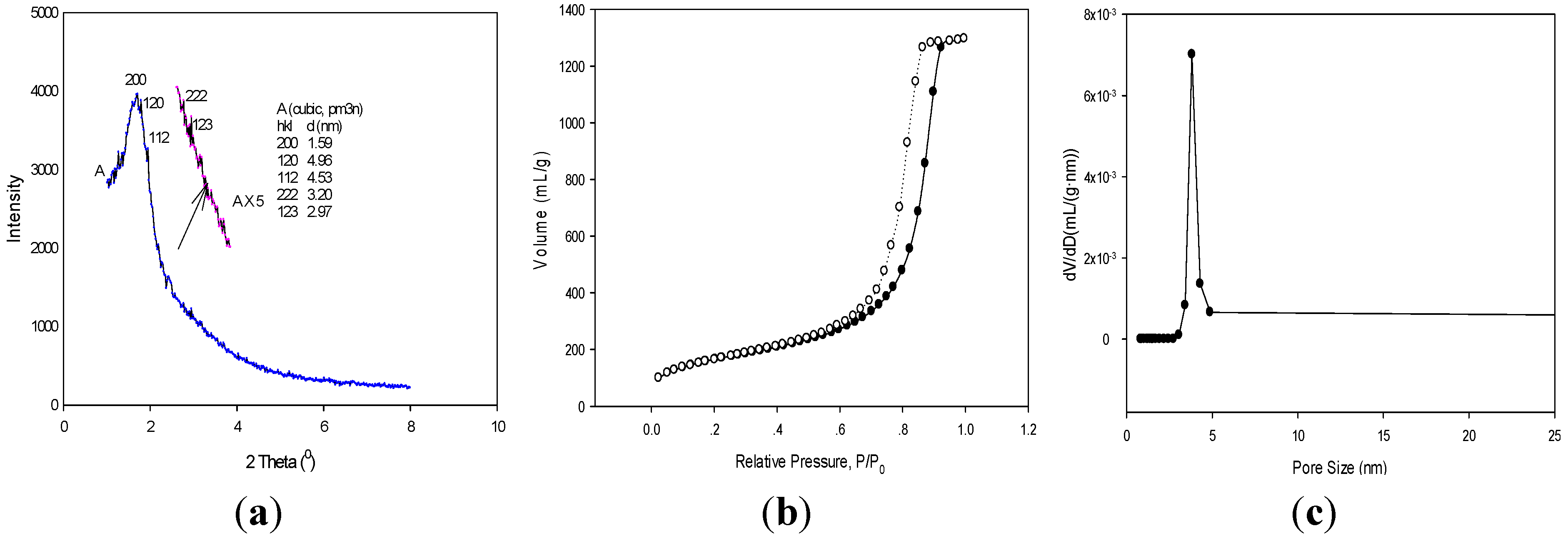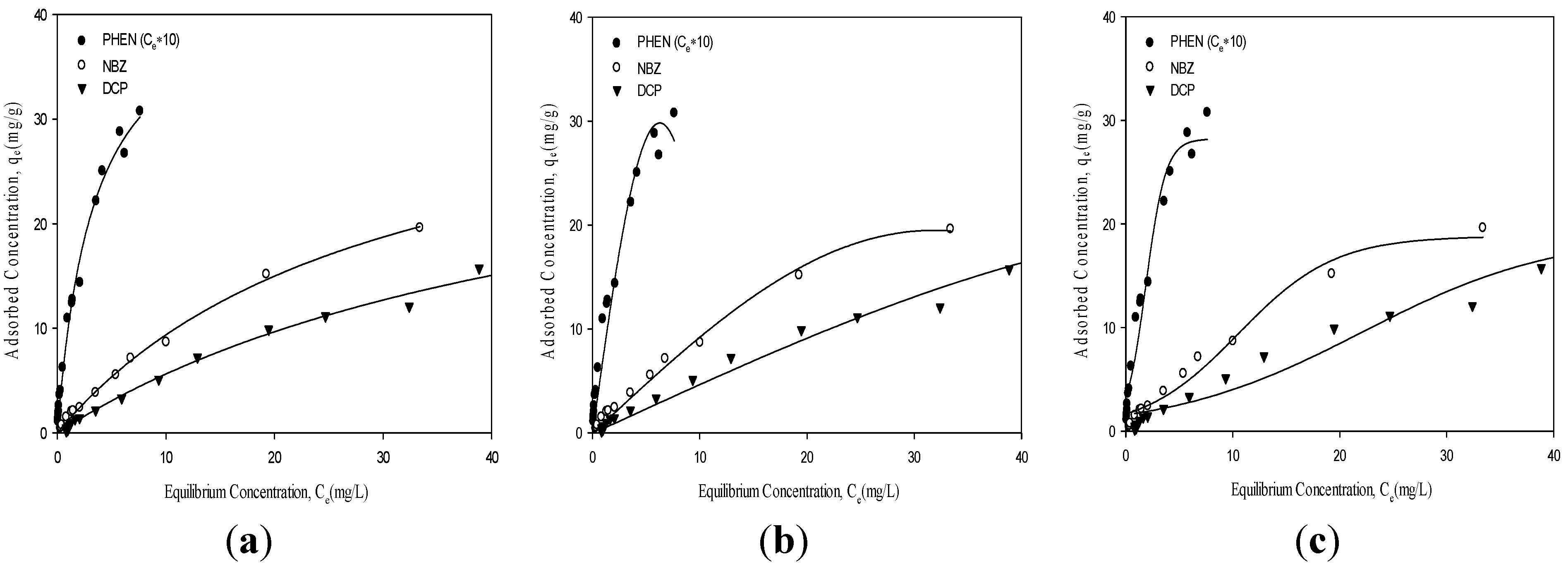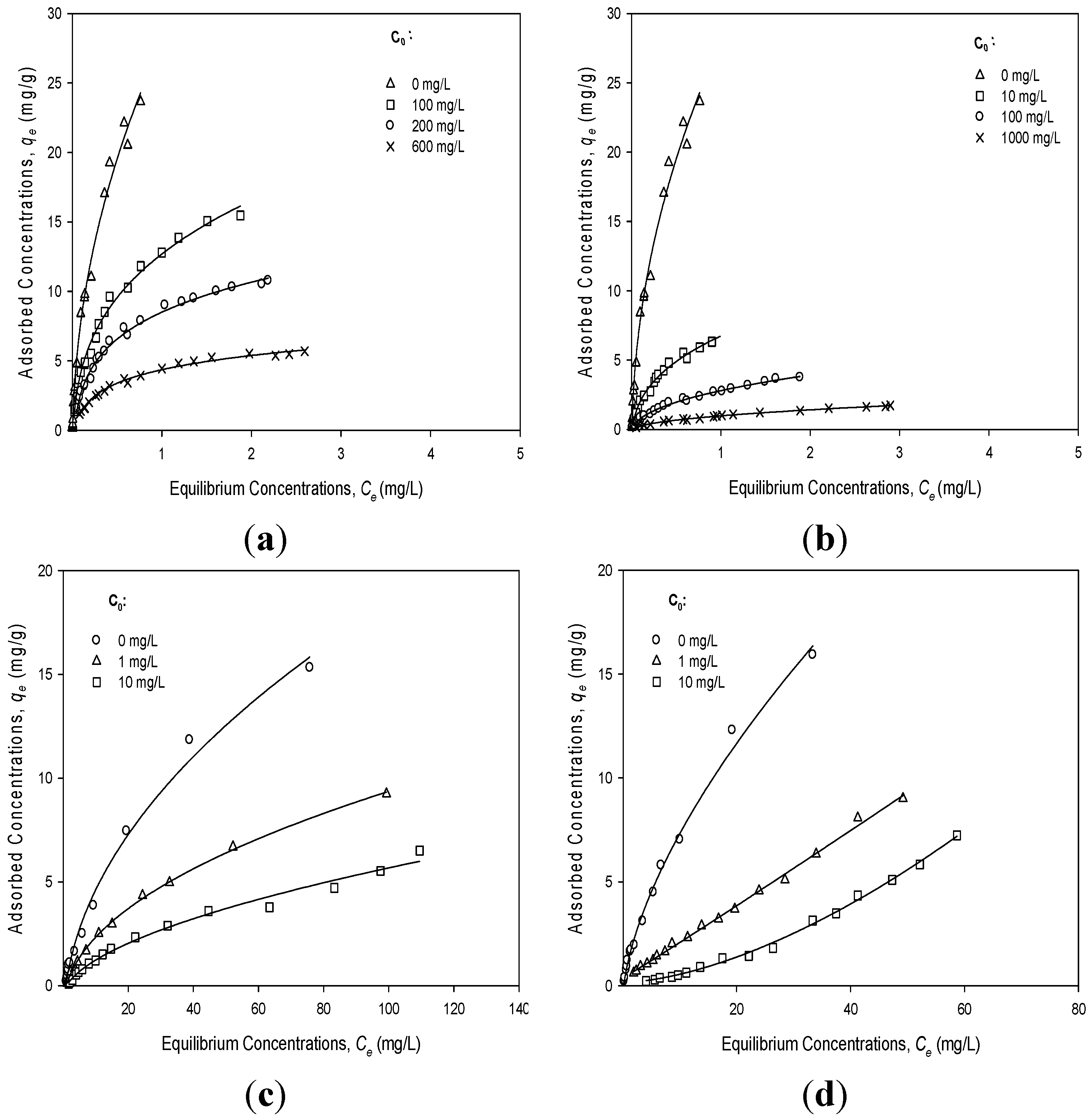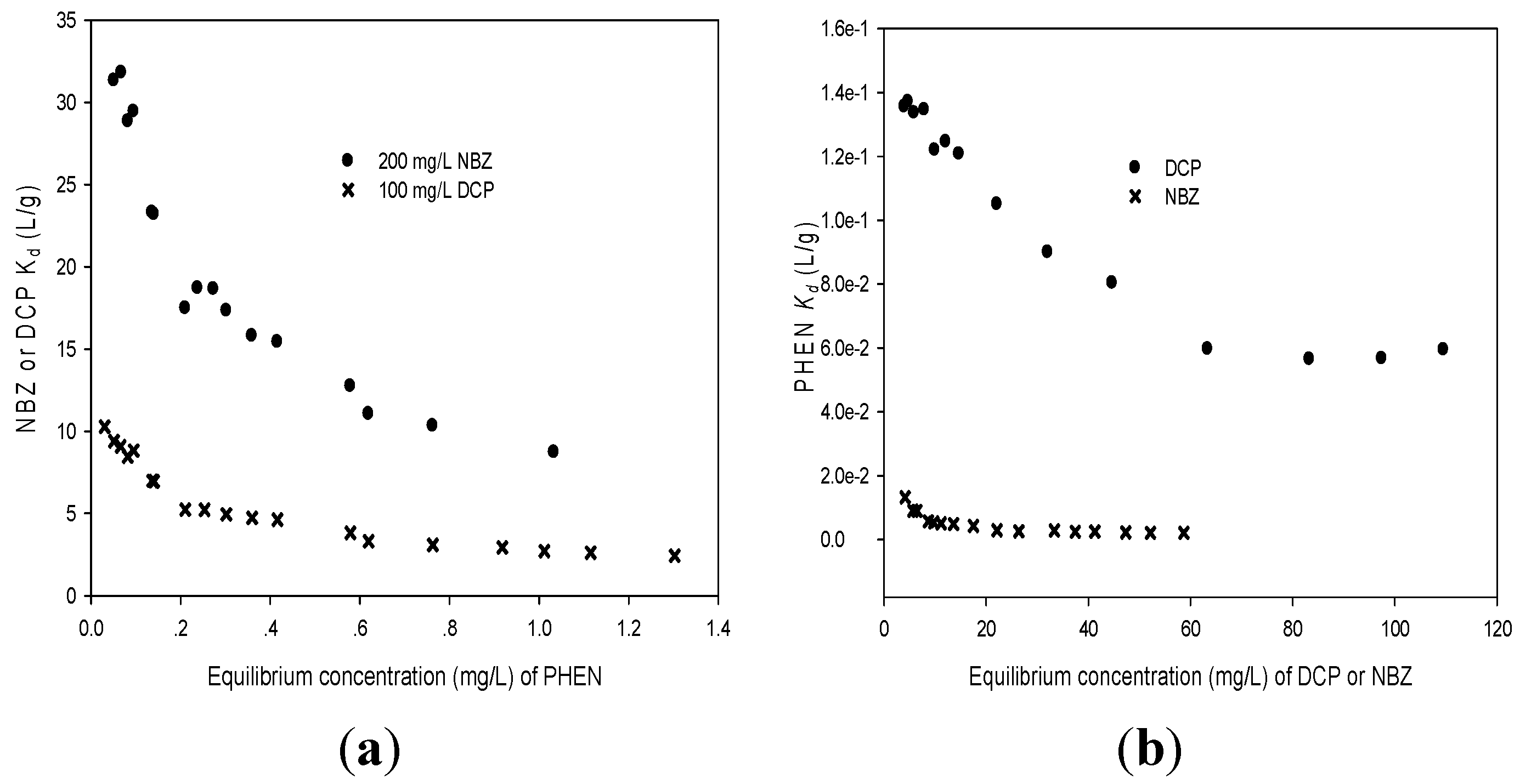Mechanisms of Competitive Adsorption Organic Pollutants on Hexylene-Bridged Polysilsesquioxane
Abstract
:1. Introduction
2. Experimental and Methods
2.1. Materials
2.2. Synthesis of Hexylene BPS
2.3. Characterization of Hexylene BPS
2.4. Organic Pollutants
2.5. Single-Solute Adsorption Isotherms
2.6. Competitive Isotherms
3. Results and Discussion
3.1. Preparation and Characterization of HBPMS

3.2. Adsorption Isotherms of HBPMS

| Isotherms | PHEN | NBZ | DCP |
|---|---|---|---|
| Freundlich | |||
| Kf | 29.10 ± 0.93 | 1.41 ± 0.04 | 0.88 ± 0.02 |
| n | 0.58 ± 0.02 | 0.88 ± 0.03 | 0.89 ± 0.03 |
| radj2 | 0.9871 | 0.9916 | 0.9886 |
| Sips | |||
| Qm | 35.85 ± 1.27 | 24.81 ± 1.11 | 23.63 ± 0.87 |
| as | 0.063 ± 0.002 | 0.049 ± 0.001 | 0.033 ± 0.001 |
| 1/n | 0.533 ± 0.02 | 0.556 ± 0.02 | 0.834 ± 0.03 |
| radj2 | 0.9574 | 0.9881 | 0.9844 |
| Toth | |||
| Qm | 69.39 ± 3.01 | 49.33 ± 2.17 | 46.98 ± 1.72 |
| KT | 1.67 ± 0.09 | 1.19 ± 0.03 | 3.86 ± 0.07 |
| n | 0.248 ± 0.01 | 0.256 ± 0.01 | 0.729 ± 0.03 |
| radj2 | 0.9639 | 0.9704 | 0.9500 |
3.3. Competitive Adsorption between PHEN and Neutral DCP/NBZ


| Primary-Sorbate (Competitor) | C0 a (mg/L) | Kf b | n c | MWSE d | radj2 |
|---|---|---|---|---|---|
| DCP | 0 | 0.88 ± 0.02 | 0.67 ± 0.02 | 0.0504 | 0.9886 |
| DCP (PHEN) | 1 | 0.81 ± 0.04 | 0.63 ± 0.02 | 0.0373 | 0.9900 |
| DCP (PHEN) | 10 | 0.79 ± 0.05 | 0.58 ± 0.03 | 0.0265 | 0.9910 |
| NBZ | 0 | 1.41 ± 0.04 | 0.70 ± 0.02 | 0.0410 | 0.9916 |
| NBZ (PHEN) | 1 | 1.32 ± 0.03 | 0.68 ± 0.05 | 0.0315 | 0.9932 |
| NBZ (PHEN) | 10 | 1.28 ± 0.05 | 0.65 ± 0.07 | 0.0298 | 0.9977 |
| PHEN | 0 | 29.10 ± 0.93 | 0.58 ± 0.02 | 0.0890 | 0.9870 |
| PHEN (NBZ) | 100 | 27.69 ± 1.13 | 0.55 ± 0.04 | 0.0203 | 0.9897 |
| PHEN (NBZ) | 200 | 25.97 ± 1.44 | 0.50 ± 0.07 | 0.0197 | 0.9911 |
| PHEN (NBZ) | 600 | 23.85 ± 1.61 | 0.42 ± 0.05 | 0.0128 | 0.9970 |
| PHEN (DCP) | 10 | 28.09 ± 1.24 | 0.53 ± 0.04 | 0.0323 | 0.9901 |
| PHEN (DCP) | 100 | 27.73 ± 1.76 | 0.49 ± 0.03 | 0.0231 | 0.9963 |
| PHEN (DCP) | 1000 | 24.96 ± 2.01 | 0.41 ± 0.06 | 0.0196 | 0.9979 |
4. Conclusions
Acknowledgments
Author Contributions
Conflicts of Interest
References
- Pelekani, C.; Snoeyink, V.L. Competitive adsorption in natural water: Role of activated carbon pore size. Water. Res. 1999, 33, 1209–1219. [Google Scholar] [CrossRef]
- Pelekani, C.; Snoeyink, V.L. Competitive adsorption between atrazine and methylene blue on activated carbon: The importance of pore size distribution. Carbon 2000, 38, 1423–1436. [Google Scholar] [CrossRef]
- Yang, K.; Zhu, L.Z.; Xing, B.S. Adsorption of polycyclic aromatic hydrocarbons by carbon nanomaterials. Environ. Sci. Technol. 2006, 40, 1855–1861. [Google Scholar] [CrossRef] [PubMed]
- Sander, M.; Pignatello, J.J. Characterization of charcoal adsorption sites for aromatic compounds: Insights drawn from single-solute and bi-solute competitive experiments. Environ. Sci. Technol. 2005, 39, 1606–1615. [Google Scholar] [CrossRef] [PubMed]
- Li, Q.L.; Snoeyink, V.L.; Mariñas, B.J.; Campos, C. Pore blockage effect of NOM on atrazine adsorption kinetics of PAC: The roles of PAC pore size distribution and NOM molecular weight. Water Res. 2003, 37, 4863–4872. [Google Scholar] [CrossRef] [PubMed]
- Pelekani, C.; Snoeyink, V.L. A kinetic and equilibrium study of competitive adsorption between atrazine and Congo red dye on activated carbon: The importance of pore size distribution. Carbon 2001, 39, 25–37. [Google Scholar] [CrossRef]
- Yang, K.; Wu, W.H.; Jing, Q.F.; Jiang, W.; Xing, B.S. Competitive adsorption of naphthalene with 2,4-dichlorophenol and 4-chloroaniline on multiwalled carbon nanotubes. Environ. Sci. Technol. 2010, 44, 3021–3027. [Google Scholar] [CrossRef] [PubMed]
- Newcombe, G.; Morrison, J.; Hepplewhite, C.; Knappe, D.R.U. Simultaneous adsorption of MIB and NOM onto activated carbon: II. Competitive effects. Carbon 2002, 40, 2147–2156. [Google Scholar] [CrossRef]
- Newcombe, G.; Morrison, J.; Hepplewhite, C. Simultaneous adsorption of MIB and NOM onto activated carbon. I. Characterisation of the system and NOM adsorption. Carbon 2002, 40, 2135–2146. [Google Scholar] [CrossRef]
- Oviatt, H.W.; Shea, K.J.; Small, J.H. Alkylene-bridged silsesquioxane sol-gel synthesis and xerogel characterization. Molecular requirements for porosity. Chem. Mater. 1993, 943, 943–950. [Google Scholar] [CrossRef]
- Lin, D.R.; Hu, L.J.; You, H.; Tolbert, S.H.; Loy, D.A. Comparison of new periodic, mesoporous, hexylene-bridged polysilsesquioxanes with Pm3n symmetry versus sol-gel polymerized, hexylene-bridged gels. J. Non-Cryst. Solids 2014, 406, 139–143. [Google Scholar] [CrossRef]
- Lin, D.R.; Hu, L.J.; Tolbert, S.H.; Li, Z.; Loy, D.A. Controlling nanostructure in periodic mesoporous hexylene-bridged polysilsesquioxanes. J. Non-Cryst. Solids 2015, 419, 6–11. [Google Scholar] [CrossRef]
- Lin, D.R.; Hu, L.J.; Li, Z.; Loy, D.A. Influence of alkylene-bridging group length on mesostructure and porosity in cubic (Pm3n) periodic mesoporous bridged polysilsesquioxanes. J. Porous Mater. 2014, 21, 39–44. [Google Scholar] [CrossRef]
- Thommes, M.; Köhn, R.; Fröba, M. Sorption and pore condensation behavior of nitrogen, argon, and krypton in mesoporous MCM-48 silica materials. J. Phys. Chem. B 2000, 104, 7932–7943. [Google Scholar] [CrossRef]
- Thommes, M.; Köhn, R.; Fröba, M. Characterization of mesoporous solids: Pore condensation and sorption hysteresis phenomena in mesoporous molecular sieves. Stud. Surf. Sci. Catal. 2002, 142, 1695–1702. [Google Scholar]
- Randtke, S.J.; Snoeyink, V.L. Evaluating GAC adsorptive capacity. J. Am. Water. Works. Assoc. 1983, 75, 406–413. [Google Scholar]
- Sips, R. On the structure of a catalyst surface. J. Chem. Phys. 1948, 16, 490–495. [Google Scholar] [CrossRef]
- Toth, J. State equations of the solid-gas interface layer. Acta Chim. Acad. Sci. Hung. 1971, 69, 311–328. [Google Scholar]
- Kim, M.J.; Ryoo, R. Synthesis and pore size control of cubic mesoporous silica SBA-1. Chem. Mater. 1999, 11, 487–491. [Google Scholar] [CrossRef]
- Huo, Q.S.; Margolese, D.I.; Ciesla, U.; Demuth, D.G.; Feng, P.Y.; Gier, T.E.; Sieger, P.; Firouzi, A.; Chmelka, B.F. Organization of organic molecules with inorganic molecular species into nanocomposite biphase arrays. Chem. Mater. 1994, 6, 1176–1191. [Google Scholar] [CrossRef]
- Rolison, D.R. Catalytic nanoarchitectures—The importance of nothing and the unimportance of periodicity. Science 2003, 299, 1698–1701. [Google Scholar] [CrossRef] [PubMed]
- Bell, A.T. The impact of nanoscience on heterogeneous catalysis. Science 2003, 299, 1688–1691. [Google Scholar] [CrossRef] [PubMed]
- Wang, X.C.; Yu, J.C.; Ho, C.M.; Mak, A.C. A robust three-dimensional mesoporous Ag/TiO2 nanohybrid film. Chem. Commun. 2005, 17, 2262–2264. [Google Scholar] [CrossRef] [PubMed]
- Lin, D.R.; Hu, L.J.; You, H.; Williams, R.J.J. Synthesis and characterization of a nanostructured photoluminescent silsesquioxane containing urea and dodecyl groups that can be patterned on carbon films. Eur. Polym. J. 2011, 47, 1526–1533. [Google Scholar] [CrossRef]
- Martin, R.J. Activated carbon product selection for water and wastewater-treatment. Ind. Eng. Chem. Prod. Res. Dev. 1980, 19, 435–441. [Google Scholar] [CrossRef]
- Lin, D.R.; Zhao, Q.; Hu, L.J.; Xing, B.S. Synthesis and characterization of cubic mesoporous bridged polysilsesquioxane for removing organic pollutants from water. Chemosphere 2014, 103, 188–196. [Google Scholar] [CrossRef] [PubMed]
© 2015 by the authors; licensee MDPI, Basel, Switzerland. This article is an open access article distributed under the terms and conditions of the Creative Commons Attribution license (http://creativecommons.org/licenses/by/4.0/).
Share and Cite
Lin, D.-R.; Hu, L.-J.; Xing, B.-S.; You, H.; Loy, D.A. Mechanisms of Competitive Adsorption Organic Pollutants on Hexylene-Bridged Polysilsesquioxane. Materials 2015, 8, 5806-5817. https://doi.org/10.3390/ma8095275
Lin D-R, Hu L-J, Xing B-S, You H, Loy DA. Mechanisms of Competitive Adsorption Organic Pollutants on Hexylene-Bridged Polysilsesquioxane. Materials. 2015; 8(9):5806-5817. https://doi.org/10.3390/ma8095275
Chicago/Turabian StyleLin, De-Rong, Li-Jiang Hu, Bao-Shan Xing, Hong You, and Douglas A. Loy. 2015. "Mechanisms of Competitive Adsorption Organic Pollutants on Hexylene-Bridged Polysilsesquioxane" Materials 8, no. 9: 5806-5817. https://doi.org/10.3390/ma8095275
APA StyleLin, D.-R., Hu, L.-J., Xing, B.-S., You, H., & Loy, D. A. (2015). Mechanisms of Competitive Adsorption Organic Pollutants on Hexylene-Bridged Polysilsesquioxane. Materials, 8(9), 5806-5817. https://doi.org/10.3390/ma8095275






